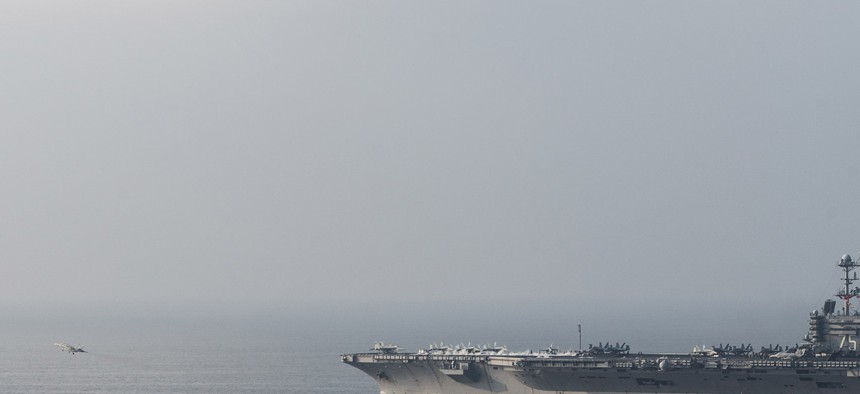
U.S. Navy photo by Mass Communication Specialist 3rd Class Taylor M. DiMartino
Think Tanks' Dream Defense Budgets Defeat China, But Not Politics
In a gaming exercise, Washington’s premier think tanks don’t even try to thwart the biggest threat of all: political gridlock. By Kevin Baron
Four of Washington’s premier think tanks presented their dream defense budgets that reveal one common theme: national security leaders know a lot more about getting past China’s defenses than they do about getting past House and Senate budget leaders.
A perfect world for think tanks, it seems, would be free of the partisan politics that govern the Pentagon and all government spending, and of the actual spending constraints limiting Defense Department strategists today. Positioning nuclear attack submarines, stealth fighters and missile defenses closer to China’s front door is an easy call. Positioning a defense authorization bill that includes modest cuts to military benefits and raises underpriced healthcare costs – well, that’s not the job of Washington’s defense spending brain trust.
The result is that what the groups undertook wasn’t so much an exercise in making hard choices in defense budgeting or strategy, rather it was a grown-up game of Risk, where maps and weapons systems come first and the resources to pay for the people that make it all possible remain a given.
Most members of the Joint Chiefs of Staff say the people come first. But the Center for Strategic and Budgetary Assessments asked teams from four think tanks to ignore personnel costs and use a nifty online calculator to add and subtract the dollar amounts and weapons stocks they would spend on a long list of budget items. First, teams had to stay under Budget Control Act spending caps. Then, in later years, they could propose to “buy back” capabilities with “more optimistic” future funding levels. CSBA did not explain why they imagine Congress would, five years from now, become more inclined to increase defense spending. Just go with it.
Additionally CSBA gave the teams a very generous starting point. Teams were told to assume all military personnel issues were accepted by Congress, including higher TriCare fees and military compensation reforms which Congress to date has flatly rejected, and assume that all efficiencies savings plans were underway and working.
These are not small givens to move the game along; these are two enormous assumptions that have little to no chance of coming true. Military personnel costs, including healthcare, are expected to eat 50 percent of the defense budget if not brought under control.
(Read more Defense One coverage of the budget here)
Under those parameters, however, the teams still came back with some interesting and surprising results. The conservatives from the American Enterprise Institute titled their presentation “Patrol, Hold, Hope – A Path to Restore American Military Preeminence.” No surprise there. They did not explain how the U.S., which outspends all of Asia’s militaries combined, is no longer the world’s preeminent military. They just want more. “Keep what you’ve got” and “buy what you can” is the AEI way, explained Tom Donnelly, co-director of the group’s Marilyn Ware Center for Security Studies. That approach means no troop cuts and AEI has DOD starting more “program of record” weapons lines.
But when AEI crunched the dreamland numbers, AEI surprised themselves. “Even at AEI… we didn’t add as much as we think we would,” Donnelly said at a dinner briefing for reporters on Tuesday evening. In the game’s “unconstrained” round, AEI’s team put defense spending lower than pre-Budget Control Act levels. “We didn’t increase the size of the Army,” he said, and they did not drastically cut civilians. Conservatives in Congress have called for as large a ground force as possible and some have used civilian DOD workers as a punching bag in recent years, hammering the Obama administration for proposing to cuts to uniform personnel they argue are disproportionately larger than civilian workforce cuts. Donnelly, however, passed on cutting civilians just yet. “I don’t know what those people are doing, but neither do you. So before I throw it away, I’d like to evaluate it.”
The center-left Center for a New American Security team showed no love for personnel, uniformed or not. “The first thing we cut was end strength, as much as we could,” said Nora Bensahel, senior fellow and co-director of the Responsible Defense Program. “Frankly, personnel is where the savings are.” All of the groups targeted the Army for major personnel cuts. Yet, CNAS proposed the largest-sized Army of all the think tanks cutting at first to 420,000 soldiers but increasing the force after five years. They also opted to include two rounds of base closures in their budgets. “We know that is politically contentious,” she conceded. In truth, base closures show no chance of making it out of subcommittee in Congress. CNAS, however, said the savings from massive personnel costs in the first five-year plan allowed them a “buying spree” in the second five-year plan.
Meanwhile, CSBA’s scenario talks much about transforming the military from being a “compellence” force to becoming deterrence force. That means adding people and training to units most likely to operate in contested areas. But it also called for allies to take over more of their own defense so that the U.S. can withdraw from (and not pay for) that responsibility as much. Never mind that consecutive U.S. defense secretaries for years have begged NATO member states to increase their share of NATO’s budget and invest more of their domestic budgets into defense spending.
The Center for Strategic and International Studies’ David Berteau seemed the most interested in playing the game, frequently nodding to the realities that would make so many of the their interesting proposals dead on arrival on Capitol Hill or at the military services. Berteau said “serious management reform” was not a big enough part of the game, which instead required teams to lop off chunks of personnel or existing hardware and future weapons spending.
One of the most obvious departure points was how to check down China. AEI called for a robust arming up of the Pacific region, including a need for new attack submarines to stay ahead of Chinese subs to come. “This is, if you will, a ‘Hunt for Red October’ moment,” said Donnelly. CSIS, Berteau said, sees containment as a bad policy for China. CSIS would prefer the U.S. instead work with every other friendly Asian nation on cost-savings measures from base access (instead of permanent bases) and shared high-end capabilities. “I’m pretty sure it’s not going to work,” he said of containing China. “We can’t spend them into the ground like with the Russians.”
CSBA’s Todd Harrison, who led the exercise, argued that the teams were told to ignore controversial military personnel cost-saving proposals for two reasons. First, the teams would have to spend too much time and energy adding and subtracting those accounts rather than on making choices to address global strategic threats, which was the point of the exercise. Second, Harrison said that CSBA feared if military personnel costs were part of the exercise then veterans groups would drown out CSBA’s debut of the exercise results at an event on Capitol Hill on Wednesday and “not allow a discussion of strategic choices.”
Beyond politics, if you suspend disbelief, there are some highlights to what the groups proposed. All four teams cut non-stealthy fighters. But only AEI adds additional stealthy capabilities, with F-35 buys. Only AEI and CSIS added non-stealth bombers. Three groups would accelerate stealthy bombers. CSIS’s Berteau said they preferred to wait for stealth technology to advance for 10 years and then make their buys. “Oh, that’ll deter China,” Donnelly scoffed.
All four teams cut naval carriers and destroyers. Other ship types only slightly increase in numbers. None of the teams proposed major increases to the Navy, despite its increased mission portfolio in the Pacific. All teams fund nuclear forces but AEI cuts out ICBMs. All of them retired all of the A-10 combat attack planes and U-2s, opting to ignore DOD planners who said U-2s were cheaper than global hawks.
NEXT STORY: Bob Work Expected To Be Named Deputy SecDef
